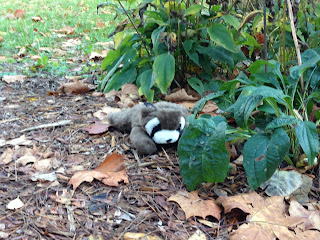“I like raccoons. I can’t understand why they’re so underappreciated—not detested like rats or opossums maybe, but not known for delivering thrills either. They’re surely one of the most cuddly looking and admirable synanthropes—what biologists call species that succeed in the human environment.” –Jon Mooallem, Wild Ones (p. 260)
One of the current favorite stuffed animals of my daughter
is a little raccoon named Starlight. We
frequently see raccoons (real ones) in our backyard and it is why Starlight had
such appeal when my daughter was making her stuffed animal selection in the
Smoky Mountains. We also have a beloved skunk living under our deck, which we
rarely see but frequently smell, and opossums and deer are also regular interlopers
in our yard. We occasionally see signs
of fox or coyotes (i.e., scat—another of my child’s obsessions). And of course
squirrels. Lots of squirrels. We’ve been live-trapping Peromyscus in our house with the change in weather (apparently our
five cats have other things to do) and there are quite a few indicators that
the moles have a virtual city beneath the surface of our yard. This is part of the mammal diversity of our
neighborhood. It is our household’s philosophy to love what is common, as much
as what is scarce.
Mooallem’s Wild One
brings up the strangeness of valuing species only when they are near their
evolutionary end. The examples of trying
to save a butterfly or a crane species when the numbers are down to dozens does
seem like a futile effort and highlights how failure to protect what is common
ends up in difficult and sometimes awkward situations. (Mimicking the mating dance of a crane in
order to get a sperm sample that can be shipped to a zoo to inseminate a female
of the beleaguered species? The horror.) I am reminded of Elizabeth Kolbert’s comments
that many of the species on the verge of extinction today (as well as the
Pleistocene mammals) have natural histories and life histories that make them
inherently susceptible to extinction when they live on a planet with
humans. The story of the characters
involved in saving the butterflies and cranes often ends with a kind of hopelessness
and acknowledgement of an unavoidable failure—but a species at the point where
intervention becomes necessary is already in a precarious situation—that we
save any of them from immediate extinction is actually somewhat surprising. While
there have been success stories, it is hard to wonder what the long-term
success will be given the price that has been paid in genetic diversity,
isolation from other populations, and the abundance within and between populations. It’s like opening Anna Karenina and reading: “All happy families are alike; each unhappy
family is unhappy in its own way.” What
is the probability that this story is going to have a happy ending? The stories in Wild Ones of the polar bear, Lange’s metalmark, and the whooping
crane have an even lower probability of a happy ending than poor Anna.
I am torn between the two ideas that, on the one hand, symbolic
efforts matter, and on the other hand, we need to be realistic and triage our
efforts. What would we do in a war zone (of which my knowledge stems from
watching reruns of M.A.S.H.)? Do you
want doctors to make symbolic efforts to save a person that is likely past
saving or is triage essential to save more lives? Of course, it’s not actually a war zone in the
US, at least—we have 7.3 billion people on planet earth, and we have more than
enough people who could help bring back species that are on the brink of
extinction—and the humans may benefit from that effort as well. However, in the
medical field, it is preferred to avoid a crisis by focusing on preventive care.
But we seem to lack an appreciation for
preventative care with wildlife. My
neighbors do not appreciate the presence of the raccoons, opossums, or
(especially) skunks, which puts the common species in the community around us
at risk.
In the biodiversity crisis, it does seem like the other war
zone analogy is that conservationists are learning as they go—they are trying
to save species in the absence of the necessary information and sometimes
without adequate resources. Certainly that appeared to be the case in all three
of the stories in Wild Ones. There is
often a limited ability to do the needed sorts of experiments to determine best
practices for some species. The crane migration is heroic, but without
experimental tests to determine the techniques that will lead to successfully
making the whooping cranes independent of human fostering and migration, then
we are not going to make fast progress.
I liked Brooke Pennypacker’s comment in Wild Ones that “Humanity caused the problem to begin with, and so
it’s very hard for humanity to solve
the problem. Because it’s humanity! …
It’s not a bird project…It’s a people project. The birds are an excuse for
doing something good” (p. 278). In the end, I am all for efforts that may be largely
symbolic—we created the crisis, not on purpose exactly, but we created it. The
least we can do is to try to help species return to being more common. Maybe in the end, that will make us more
human.


No comments:
Post a Comment